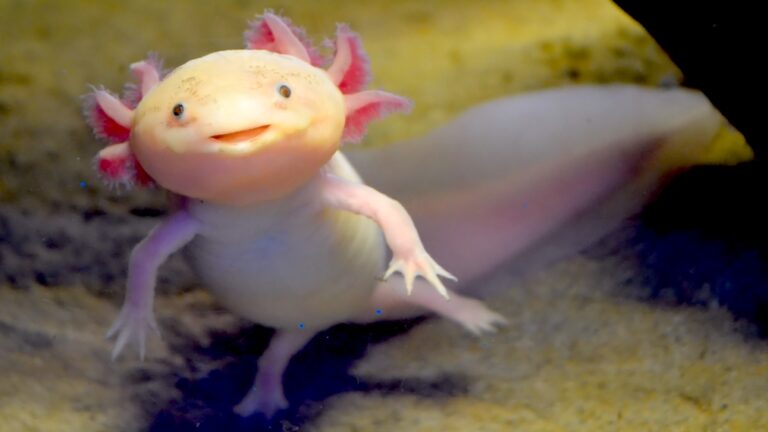The Axolotl, (pronounced ACK-suh-LAH-tuhl), is a fascinating creature, recognized by its very unique appearance, with button-like eyes and a seemingly perpetual grin plastered on its adorable face. Known by its scientific name, Ambystoma mexicanum, it is a paedomorphic salamander related to the tiger salamander. The Axolotl is commonly referred to as the Mexican Walking Fish by Australians and New Zealanders, although it is not a fish but an amphibian, part of the order Caudata/Urodela. Another common misconception is that axolotls and other salamanders are lizards or reptiles.

This species was naturally occurring in several lakes, such as Lake Xochimilco and Lake Chalco in the southern Mexico City, but nowadays, it is seldom spotted in person as its population has dramatically dropped in the wild. The axolotl is currently on the International Union for Conservation of Nature’s annual Red List of threatened species and considered as Critically Endangered.
As mentioned by Richard Griffiths, an ecologist at the University of Kent in Canterbury, UK, “The axolotl is a complete conservation paradox.” Tens of thousands can be found in home aquariums, pet shops and research laboratories around the world, and yet it’s on the brink of extinction in the wild.
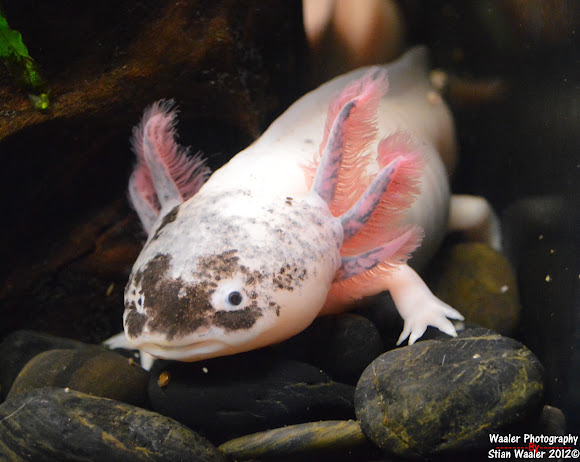
(Source: Waaler Photography/Stian Waaler)

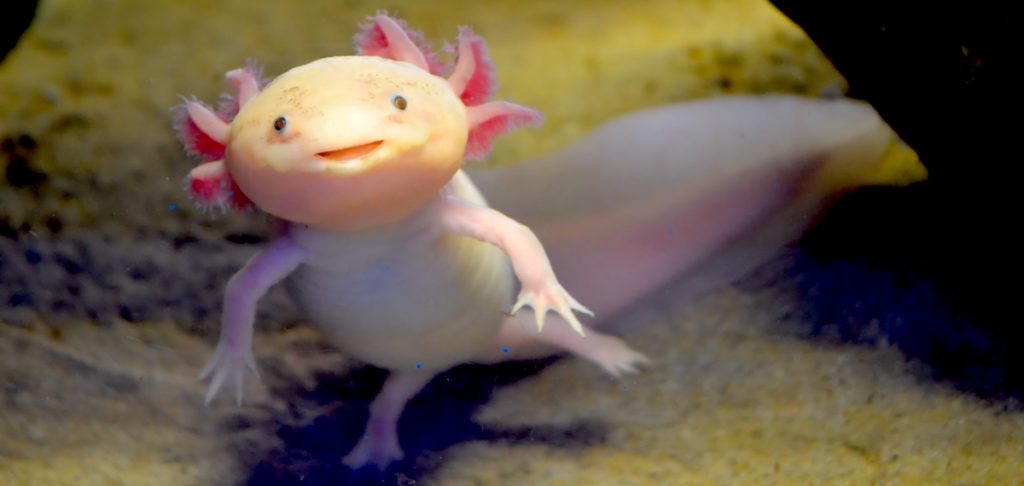
The word “Axolotl” originates from the Nahuatl language of the Aztecs and its most commonly accepted translation is “water-dog” (“atl” for water, and “xolotl”, which can also mean dog). The Axolotl has a mythological connection to Xolotl, the God of fire, lightning, deformities and death. According to some legend, Xolotl disguised himself as a salamander to avoid being sacrificed.
An adult Axolotl reaches sexual maturity at the age of 18–26 months and its size ranges from 15 to 45 cm (6 to 18 in) in length, although its most common size is closer to 23 cm (9 in). It can be quite rare to find an Axolotl larger than 30 cm (12 in). They have large heads and lack moveable eyelids. Their limbs are underdeveloped and are equipped with long, thin digits. Males are differentiated by their swollen cloacae lined with papillae, while females are recognized by their wider bodies full of eggs.


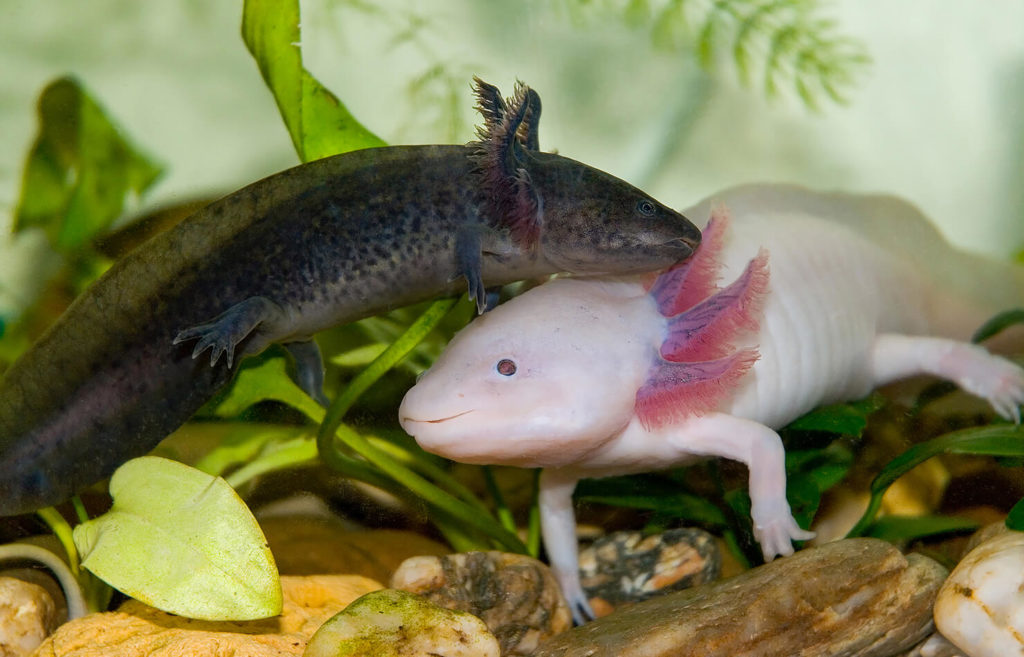
Axolotls possess features that are similar to salamander larvae, including external gills and a caudal fin extending from behind the head to the vent. There are three pairs of external gill stalks (rami) emerging from behind their heads and their function is to move oxygenated water. Numerous filaments (or fimbriae) line the gill stalks, giving them the appearance of soft feathers. These in fact increase the surface area for gas exchange and allow the amphibian to breathe underwater. Four-gill slits lined with gill rakers are hidden underneath the external gills, and their purpose is to prevent food from entering and allow particles to filter through. Axolotls are much more aquatic than other salamander species and although it possesses rudimentary lungs, it breathes essentially through its gills and to a lesser degree, its skin.
Read Also: The Leafy Sea Dragon, A Visually Spectacular Sea Creature With Incredible Camouflage
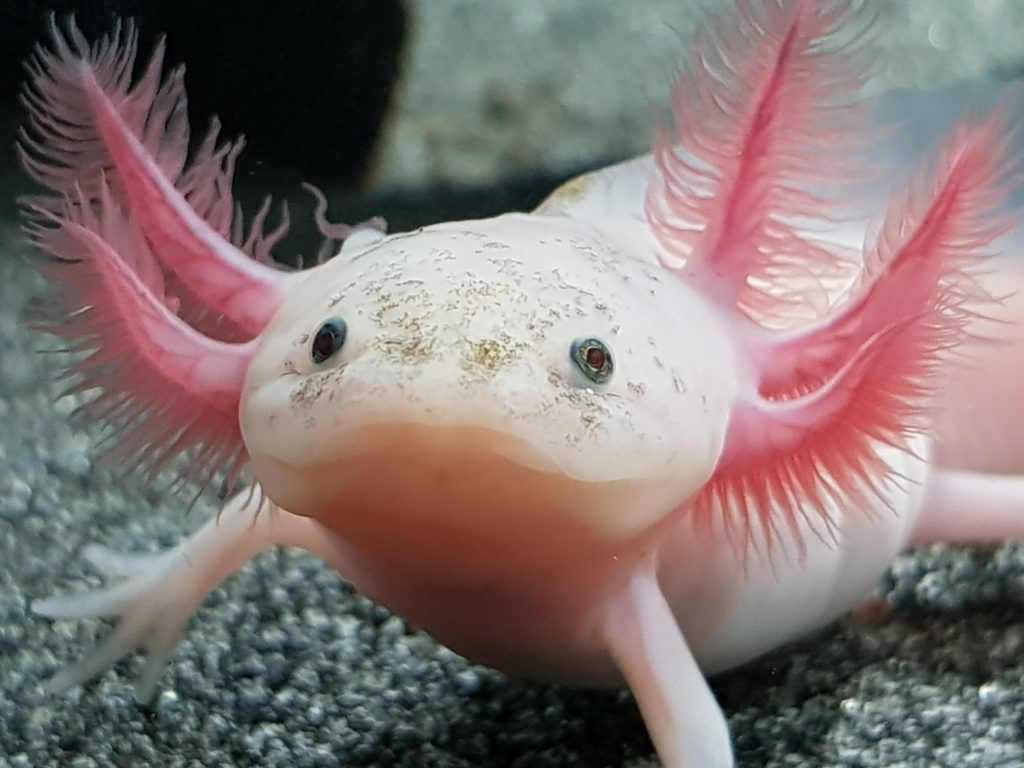
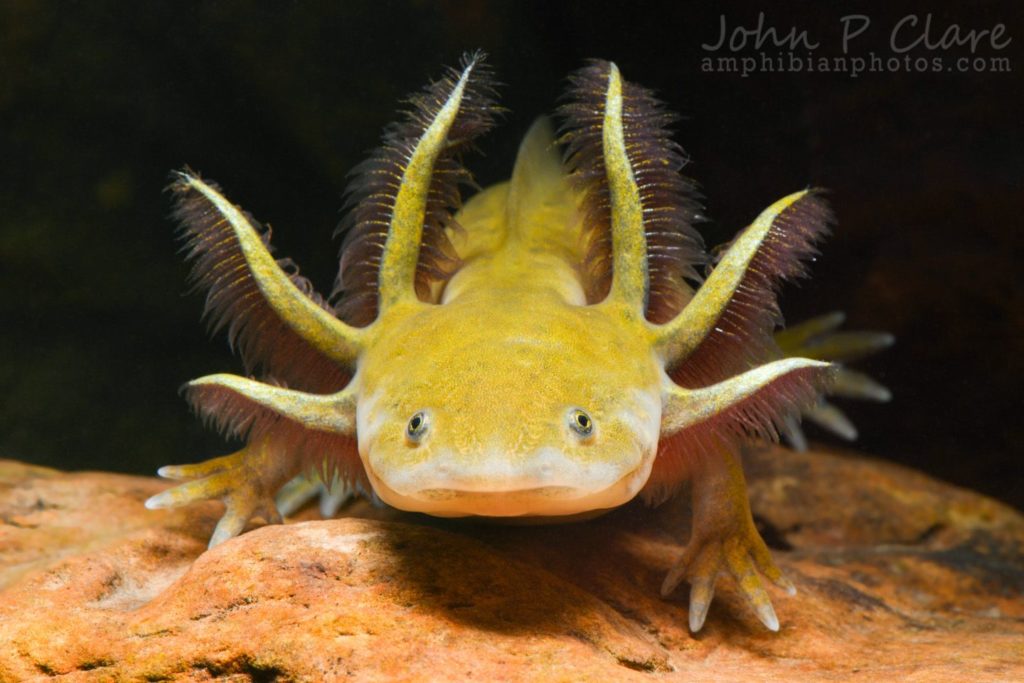

Usually, external gills disappear when salamander species enter adulthood and undergo metamorphosis, and become terrestrial. However, the axolotl retains this characteristic. This is because the axolotl doesn’t outgrow its larval, juvenile stage – a phenomenon called neoteny. Therefore, it keeps its gills and fins, doesn’t develop the protruding eyes and eyelids, and features of other adult salamanders. It attains a much larger size than a normal larval salamander, reaching sexual maturity in this larval stage, and is able to reproduce.
The axolotl is unusual in that it is deficient in thyroid stimulating hormone, which is required for the thyroid to produce thyroxine and that would allow the animal to go through metamorphosis. However, if administered the necessary hormone, its body has the capacity to go through metamorphosis. But since axolots do not produce it, they must be exposed to it from an external source. This will lead to the amphibian undergoing an artificially-induced metamorphosis and start to live on land. One method of artificial metamorphosis induction is through an injection of iodine, which is used in the production of thyroid hormones.


(Source: Reddit u/sootyowl)
An axolotl going through metamorphosis will encounter several types of physiological changes that will help them to adapt to their terrestrial life. Thus, muscle tone increases in its limbs, the gills and fins are absorbed into the body, eyelids are developed, as well as the skin’s permeability to water is reduced, all of which would enable the axolotl to stay more easily hydrated when living on land. The lungs, although already present alongside the gills in a non-metamorphosed adult, would evolve further during metamorphosis.
There are different color variations of the axolotl. The normally colored axolotl, referred to as the wild-type, can be brown or tan with gold speckles and an olive undertone, near black or even creamy in color, and anywhere in between. These amphibians have four pigmentation genes; when mutated they create different color variants. Among these mutant colors, the five more common ones are: leucistic (pale pink with black eyes), golden albino (golden with gold eyes), xanthic (grey with black eyes), albino (pale pink/white with red eyes) and melanoid (all black/dark blue with no gold speckling or olive tone). The albino color variant is more common in axolotls than some other creatures.

Source: Skylar Knox

Source: Ivy’s Axolotls

Furthermore, the size, frequency and intensity of the gold speckling vary extensively per individual. There are also “piebald” axolotls in various colors, and one variant develops a black and white piebald appearance upon reaching maturity. A variety that is piebald in more than one colour is known as the “harlequin”. Double homozygous mutants are common in the pet trade since pet breeders frequently cross the variant colors, especially white/pink animals with pink eyes that are double homozygous mutants for both the albino and leucistic trait. Axolotls are capable to only some extent to change their color to serve as camouflage by altering the relative size and thickness of their melanophores.
Read Also: Top 12 Most Unusual and Creepiest Fish In The World
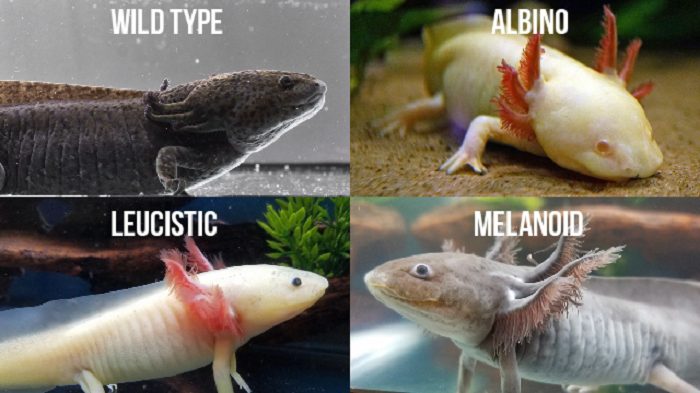

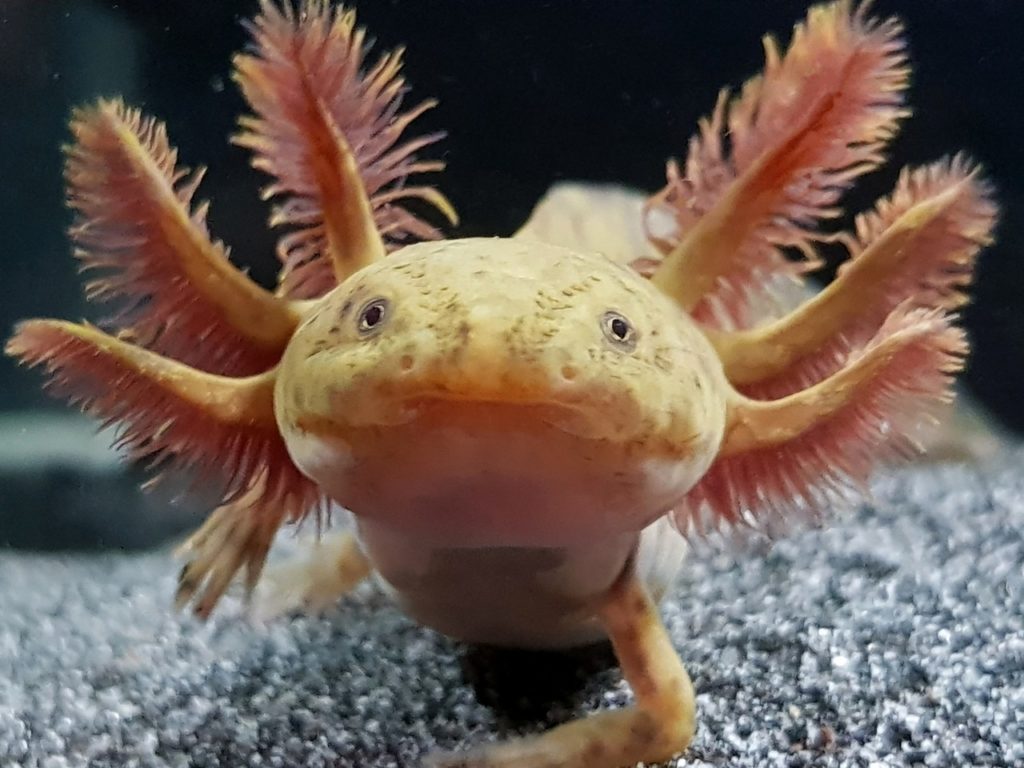
(Source: Reddit u/karayna)
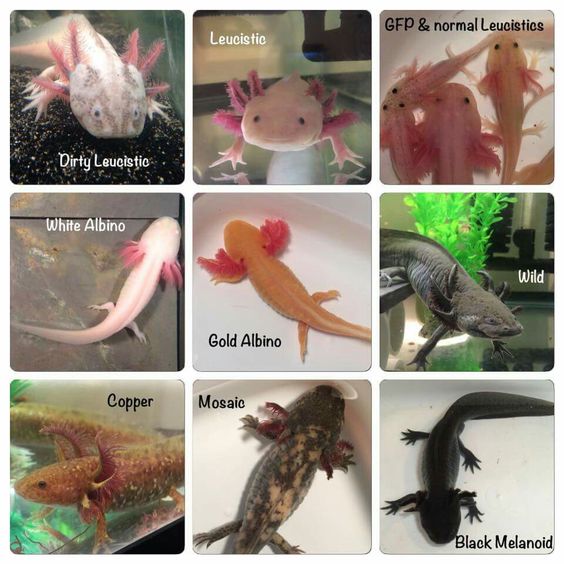
An exceptional characteristic of the axolotl that captures a lot of attention is its extraordinary healing and regeneration abilities. In other animals, normal wound healing happens through the growth of scar tissue, which is different from the original tissue, and it isn’t as sturdy. Normal wound healing also does not allow for most animals to regrow a lost limb, but this is not the case for the axolotl. Indeed, the animal does not heal by scarring and is capable of regenerating entire lost appendages in a period of months.
These incredible abilities are what have fascinated scientists and have made them an important subject of study in laboratories for everything from tissue repair to development and cancer. In certain cases, more vital structures, such as tail, limb, central nervous system, and tissues of the eye and heart are regrown or replaced. Axolotls can even restore less vital parts of their brains while another impressive capability is to readily accept transplants from other individuals, including eyes and parts of the brain, and restoring these foreign organs to full functionality.
Read Also: 34 Stunning Albino And Leucistic Animals That Exist In The World
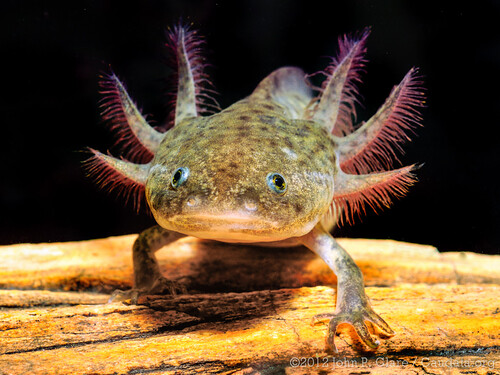
Source: John P Clare
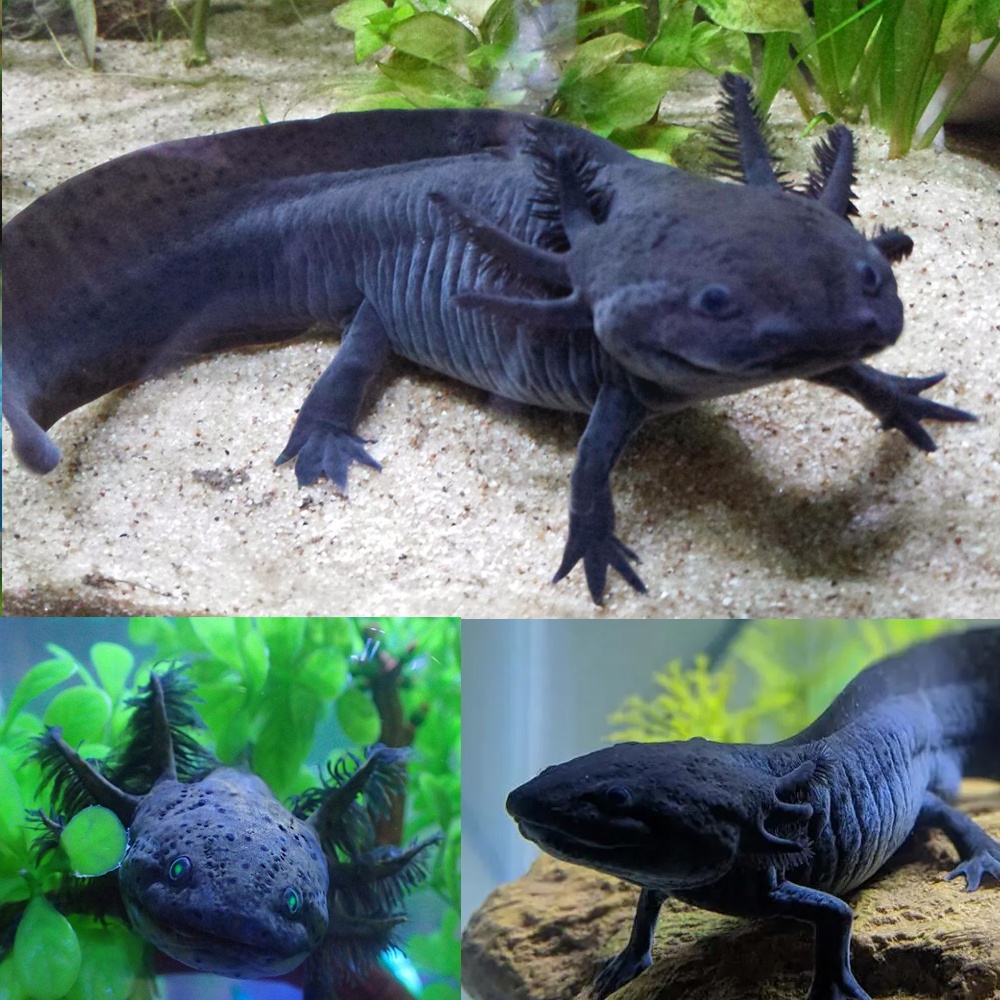
Source: aquariumfishonline.com.au
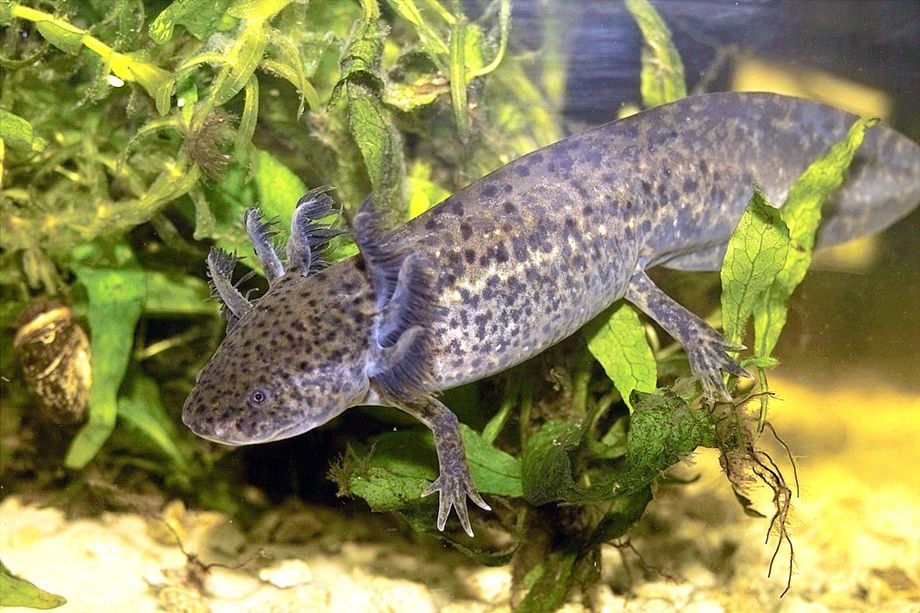
Source: Frank Ambrock
It has happened that axolotls have not only repaired a damaged limb but regenerated an additional one as well, resulting in an extra appendage that makes them attractive to pet owners as a novelty. Scientists have found that axolotls can regrow a new limb five times perfectly, within a few weeks and without even a scar. In fact, every tissue is replaced, from the skin to the bone, cartilage, muscle, and stem cells. As well, other organs can regenerate countless times and be completely functional. It is said that axolotls are over 1,000 times more resistant to cancer than mammals— yet another one of their super abilities! Many scientists have assumed that, due to the fact that the amphibian is neotenic, they conserve some trait from their embryonic stages, although other salamanders seem to regenerate even as adults.
For a limb to start regenerating, there are three basic requirements: the wound epithelium, nerve signaling, and the presence of cells from the different limb axes. A wound epidermis is quickly formed by the cells to cover up the site of the wound. Over the next days, the cells of the wound epidermis divide and grow rapidly to form a blastema. This indicates that the wound is ready to heal and go through patterning to form the new limb.
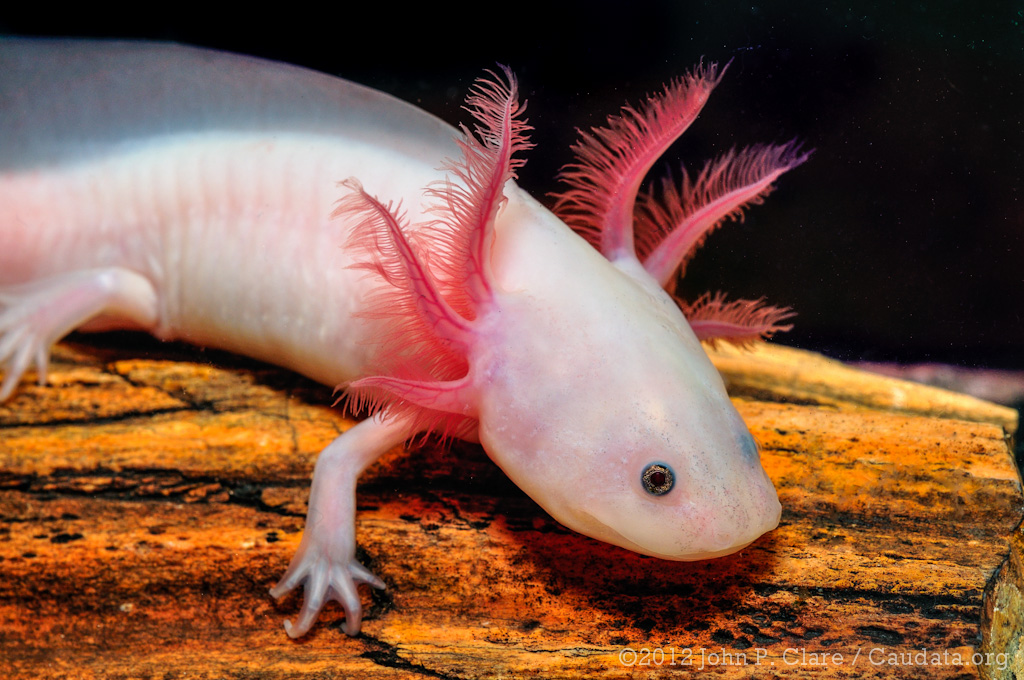
In the human body, these kinds of wound get covered with skin tissue, on the other hand, axolotls transform nearby cells into stem cells and even recall others from further away to gather near the injury. Bones, skin and veins are being formed by the cells in almost a similar manner as when the animal was developing inside the egg. Each tissue contributes its own stem cells to the effort.
However, in metamorphosed individuals, the ability to regenerate is greatly diminished. As well, captive populations as a result of centuries of inbreeding are more vulnerable to disease. The loss of genetic diversity in wild axolotls due to their declining population signifies that scientists are unable to learn all that they can about the animal’s biology.
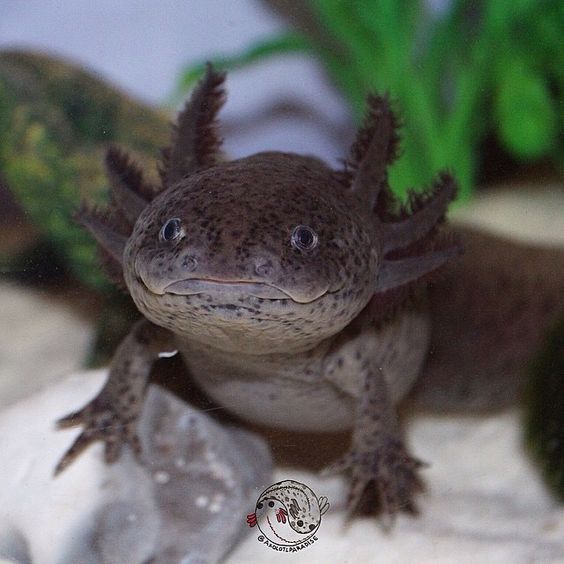
Despite having barely noticeable, undeveloped teeth, axolotls are impressive predators. Their primary method of feeding is by a suction technique, during which their rakers interlock to close the gill slits. They consume worms, mollusks, crustaceans, tadpoles, insect larvae, and even small fish. During the process, they may also swallow gravel, which helps grind up food in the belly (the same way birds use grit to break down food for digestion).
At daytime, they burrow into the aquatic vegetation and mud to avoid being detected by predators, and at night they become active and for sure, hungry. Although they breathe underwater through the use of their gills, they may occasionally come up to the surface for a quick gulp of air. This action referred to as buccal pumping can occur in a two-stroke manner that pumps air from the mouth to the lungs, and with a four-stroke that reverses this pathway with compression forces.
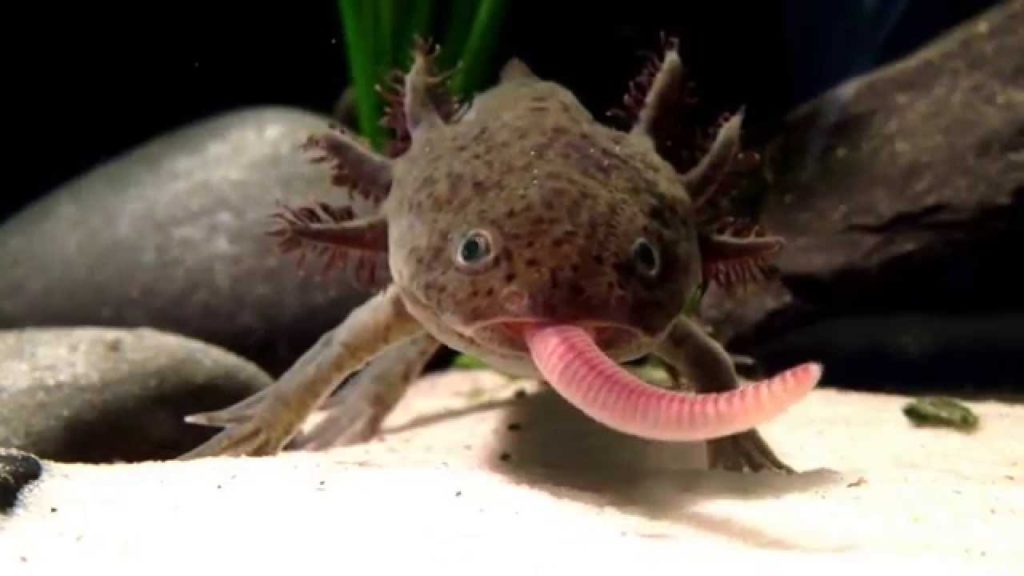

Source: bukowsky (caudata.org)
Axolotls are solitary creatures, and they attain sexual maturity between 6 – 12 months of age. The breeding season in the wild is between February to June, when water temperatures and levels are more temperate. Reproduction is stimulated when the female is full of eggs that are ready to be fertilized. She releases pheromones in the water, which is detected by the male, and he will start his search for the female. After which, the male performs a short courtship “hula” dance, shaking its tail and lower body. The female responds by nudging him with her snout, and then they initiate mating. The pair will rub and slide against the other’s cloaca (private area behind the back legs) while twirling circularly.
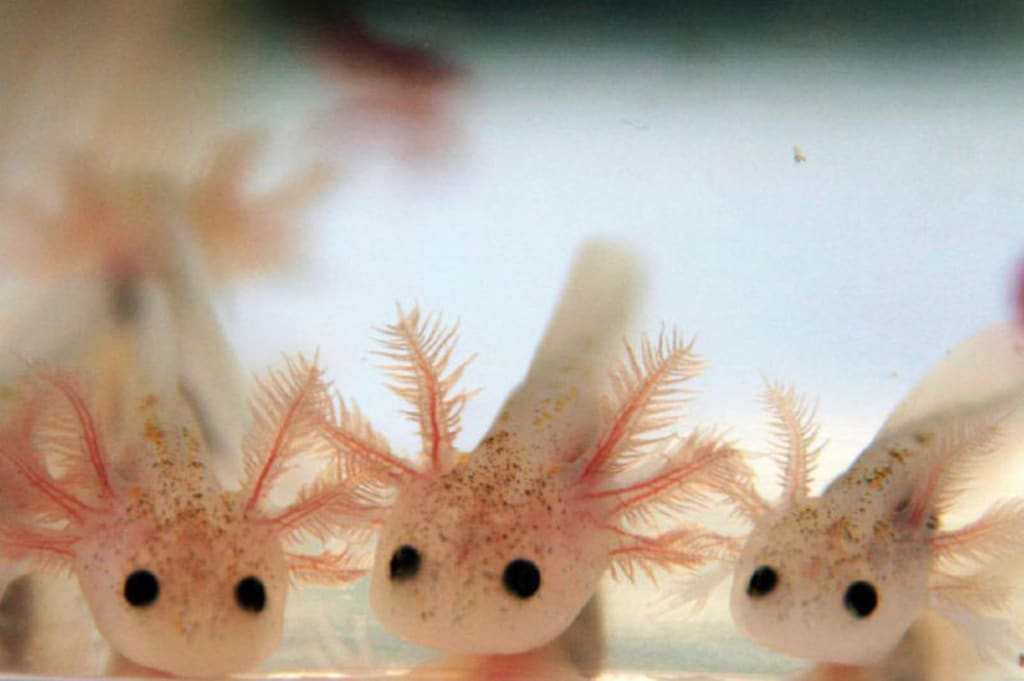
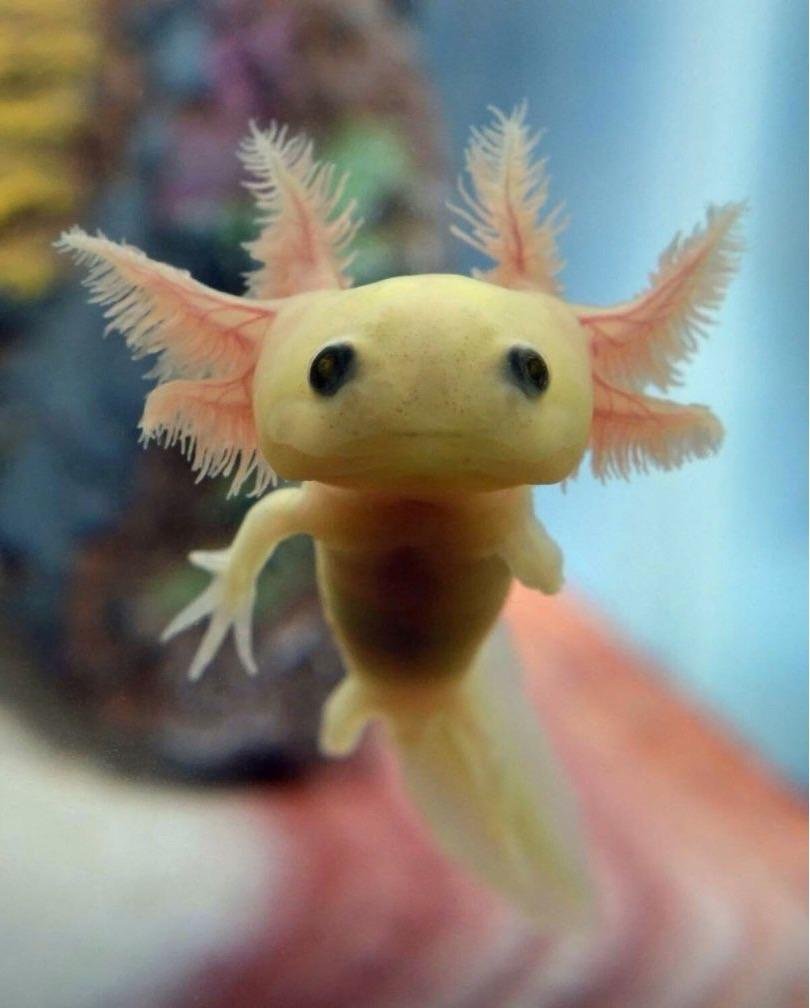
After waving its tail vigorously for about 30 seconds, the male deposits spermatophores which are a cone-shaped mass with a sperm cap on the lake floor. Afterwards, the female positions herself above the spermatophores and with her cloaca she sucks them into her abdomen full of eggs that will then be fertilized. Females lay on average 300 eggs, but it can even be up to 1,000 eggs, and this is done individually, being deposited on plant material or rocks which protect them from predators. Two weeks later, the eggs hatch and the larvae are off, swimming on their own with no parental care. However, it is interesting to note that newly hatched axolotls, will sometimes feed on their siblings’ limbs as they are hungry. Well, the limbs will grow back after all!
Read Also: Rare Golden Possum Rescued In Australia Looks Like A Real-Life Pokemon. Meet Pikachu!
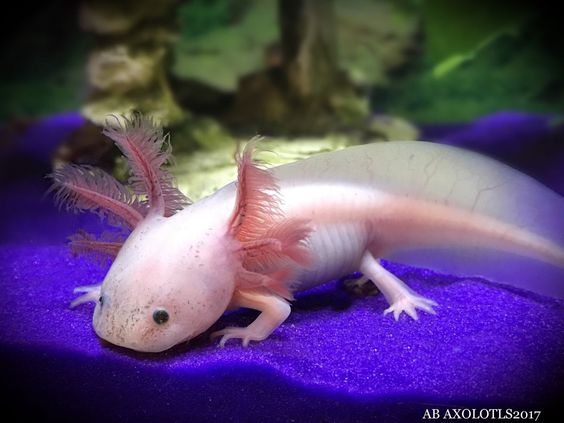
Axolotls have, for a long time, been a subject of fascination, but they gained even more popularity when they were first brought from Mexico to Paris in 1864. There, the breeding of the amphibian started all across the European continent, launching a durable pet trade for an animal that breeds easily in captivity. The axolotl has inhabited central Mexico for only about the last 10,000 years, according to some experts, and as such is considered ‘young’. Native to the two spring-fed lakes, Lake Xochimilco and Lake Chalco in the southern Mexico City neighborhood of Xochimilco, the axolotl is on the verge of extinction.
However, Lake Chalco, once about 77 square miles (200 km²) of marshes, swamps, and lagoons, was considerable reduced 85 years ago due to drainage projects that were conducted as a flood control measure. As for Lake Xochimilco, it is only a remnant of its former self, existing mainly as canals. The water temperature in Xochimilco rarely rises above 20 °C (68 °F), although it may fall to 6–7 °C (43–45 °F) in the winter, and perhaps lower.
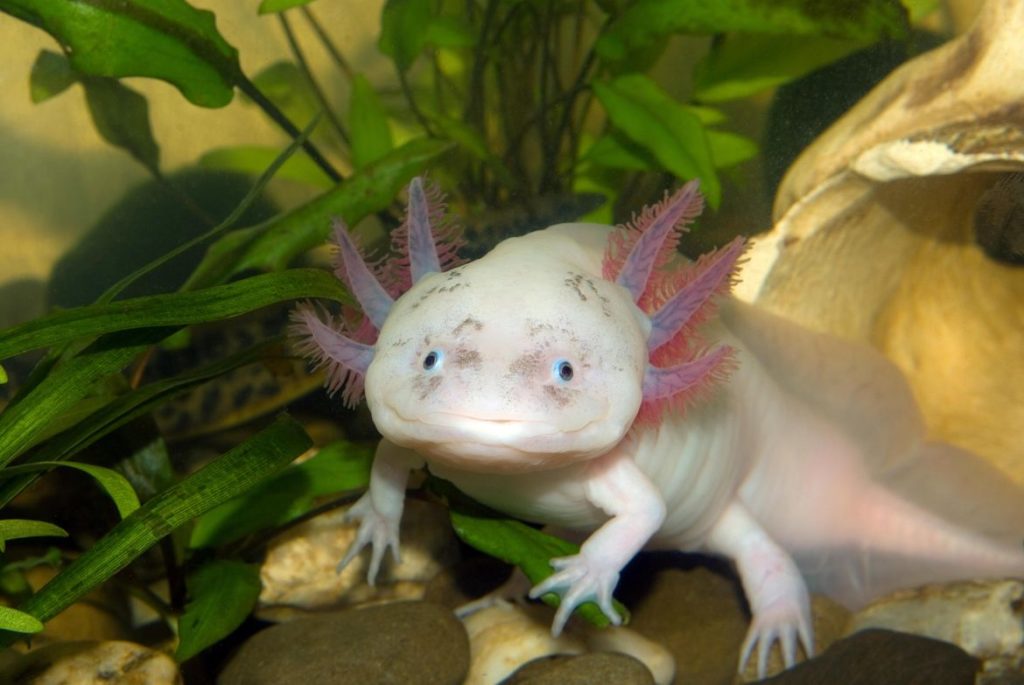
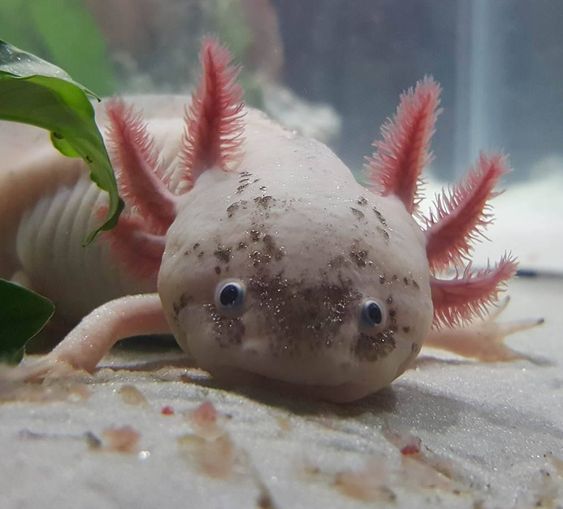
According to surveys carried out in 1998, 2003, and 2008, the number of axolotls found per square kilometer in its Lake Xochimilco habitat were 6,000, 1,000, and 100 respectively. In 2013, a four-month-long search showed no signs of surviving individuals in the wild. Though, a month later, two wild specimens were spotted in a network of canals leading from Xochimilco.
A 2019 assessment by the International Union for the Conservation of Species concluded that only between 50 and 1000 axolotls exist in the wild, with their population on the decline. Indeed, their natural habitat has suffered much degradation due to development for tourism and residential housing, as well as agricultural and industrial pollution. The reduction in the species’ population is also caused by the introduction of non-native and invasive fish such as African tilapia and Asian carp to the waters. These new fish have been eating the axolotls’ young, but also competing with adults for their primary source of food.
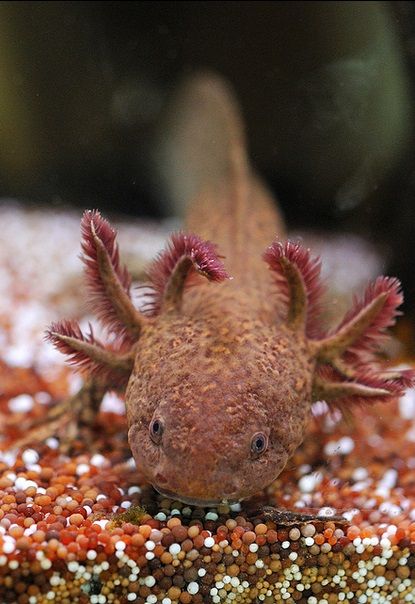
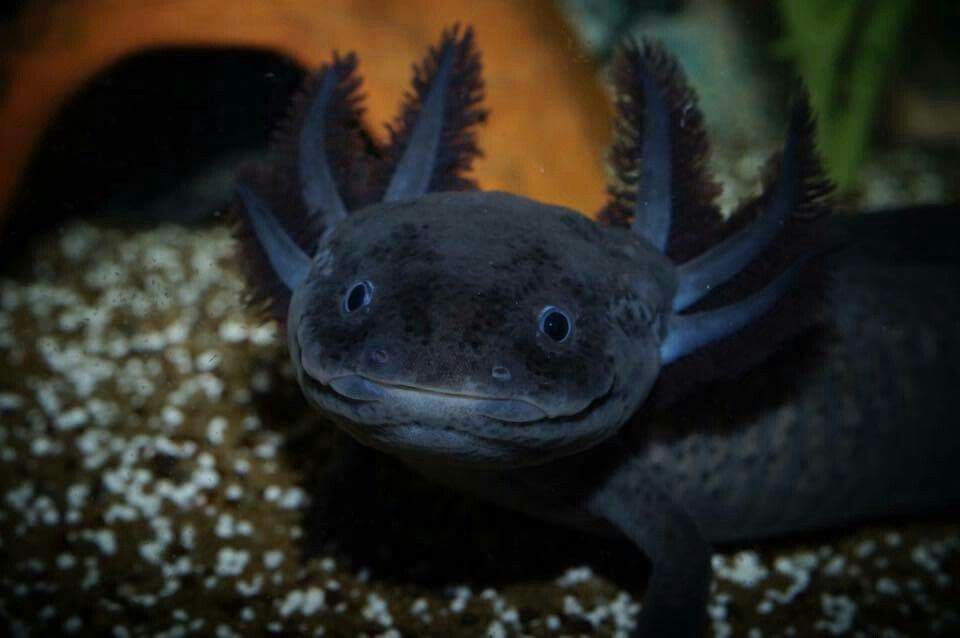
The Mexican government, together with many nonprofit organizations are trying to rescue the axolotls, partly by restoring several areas of their freshwater habitat and by promoting ecotourism for people to see these very peculiar salamanders in the wild. This entails scientists and farmers working together to help filter the polluted water by building chinampas, which are basically floating islands made of aquatic vegetation, logs and lake mud.
Latest articles:
- Silent Killers of the Sea: Fishing Nets and the Devastating Impact on Our Oceans
- Amazing Ability of Sharks to Regrow Their Dorsal Fins
- Mountain Marvels: 7 Architectural Wonders Built into Nature’s Slopes
- The Frilled Shark: Jaws of the Abyss and a Living Fossil
- 30 Christmas Rock Painting Ideas – Last minute DIY crafts for Christmas decor, gifts and stocking fillers

